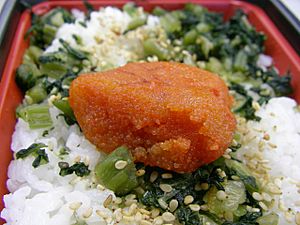Nozawana facts for kids
Quick facts for kids Nozawana |
|
|---|---|
 |
|
| Nozawana | |
| Scientific classification | |
| Kingdom: | |
| (unranked): | |
| (unranked): | |
| (unranked): | |
| Order: | |
| Family: | |
| Genus: | |
| Species: |
B. rapa (syn B. campestris)
|
| Trinomial name | |
| Brassica rapa L. var. hakabura |
|

Nozawana (野沢菜) is a special Japanese leaf vegetable. It is often pickled, which means it's preserved in a salty or sour liquid. This plant is related to the common turnip and is a type of mustard leaf. Its long leaves can grow to be about 60 to 90 centimeters (2 to 3 feet) in length. The scientific name for Nozawana is Brassica rapa L. var. hakabura.
What is Nozawana?
Nozawana is a popular green leafy vegetable from Japan. It belongs to the same plant family as cabbage, broccoli, and radishes. People usually eat it after it has been pickled. This process gives it a unique salty and tangy flavor. It's a common side dish in many Japanese meals.
Where Does Nozawana Come From?
The story of Nozawana began a long time ago, between the years 1751 and 1764. It is believed that a Buddhist temple master brought the plant from the mountains of Kyoto Prefecture. He took it to a village called Nozawa-onsen in Nagano Prefecture. An "onsen" is a Japanese hot spring.
The plant grew very well around this village. Because of this, people started calling it Nozawana. The word "na" in Japanese means "vegetable." So, Nozawana literally means "Nozawa vegetable."
How is Nozawana Used?
Pickled Nozawana is a very famous food in Nagano Prefecture, Japan. It is a traditional local dish that many people enjoy. You can find it served with rice or as part of a meal.
It is also often used in onigiri, which are Japanese rice balls. The salty, crunchy Nozawana adds a great flavor and texture to these popular snacks. It's a simple but delicious way to enjoy this unique vegetable.
See also
 In Spanish: Nozawana para niños
In Spanish: Nozawana para niños

